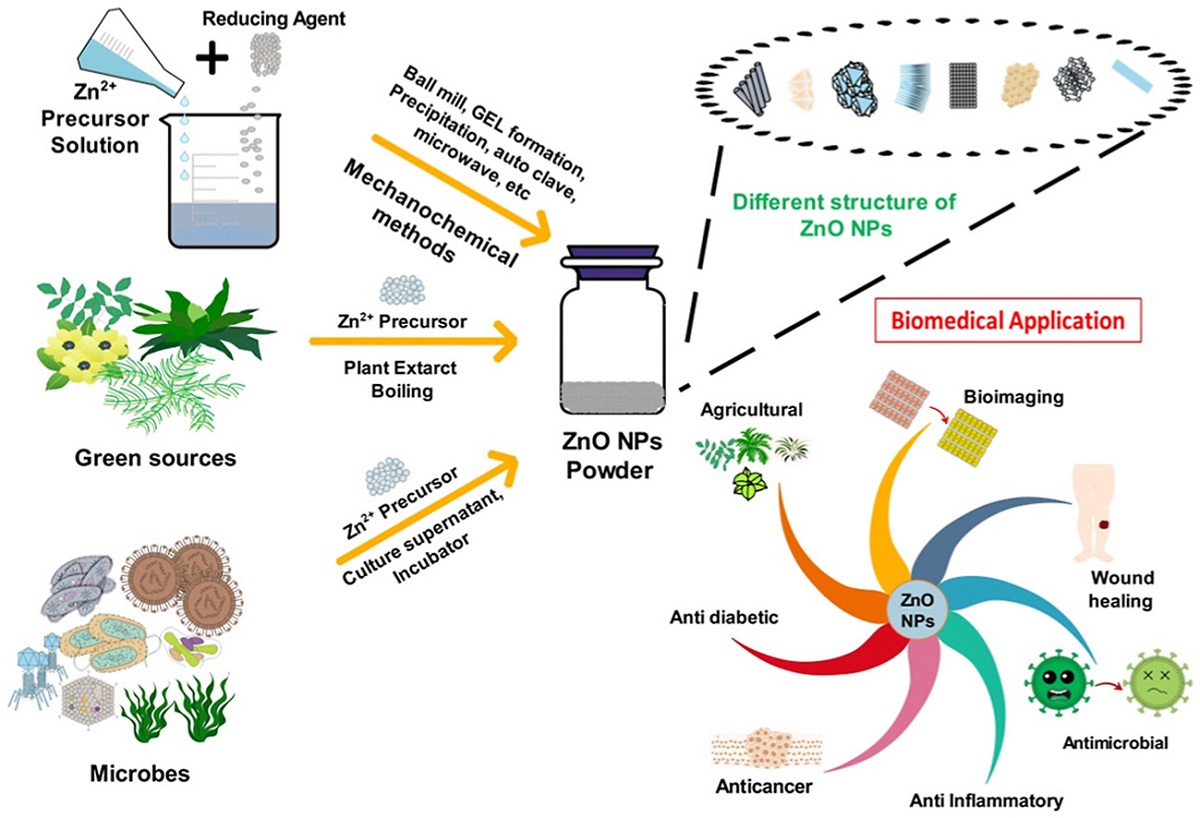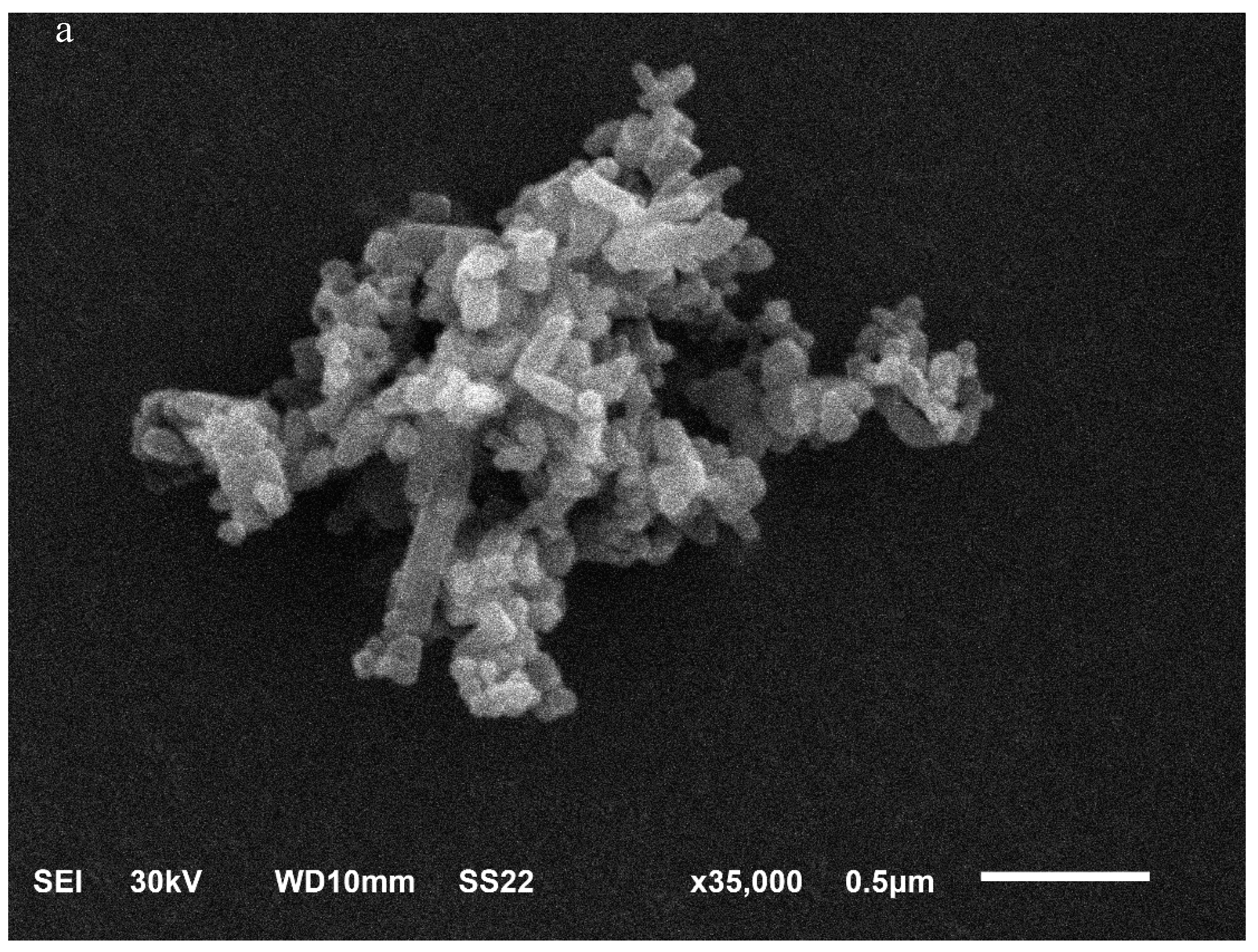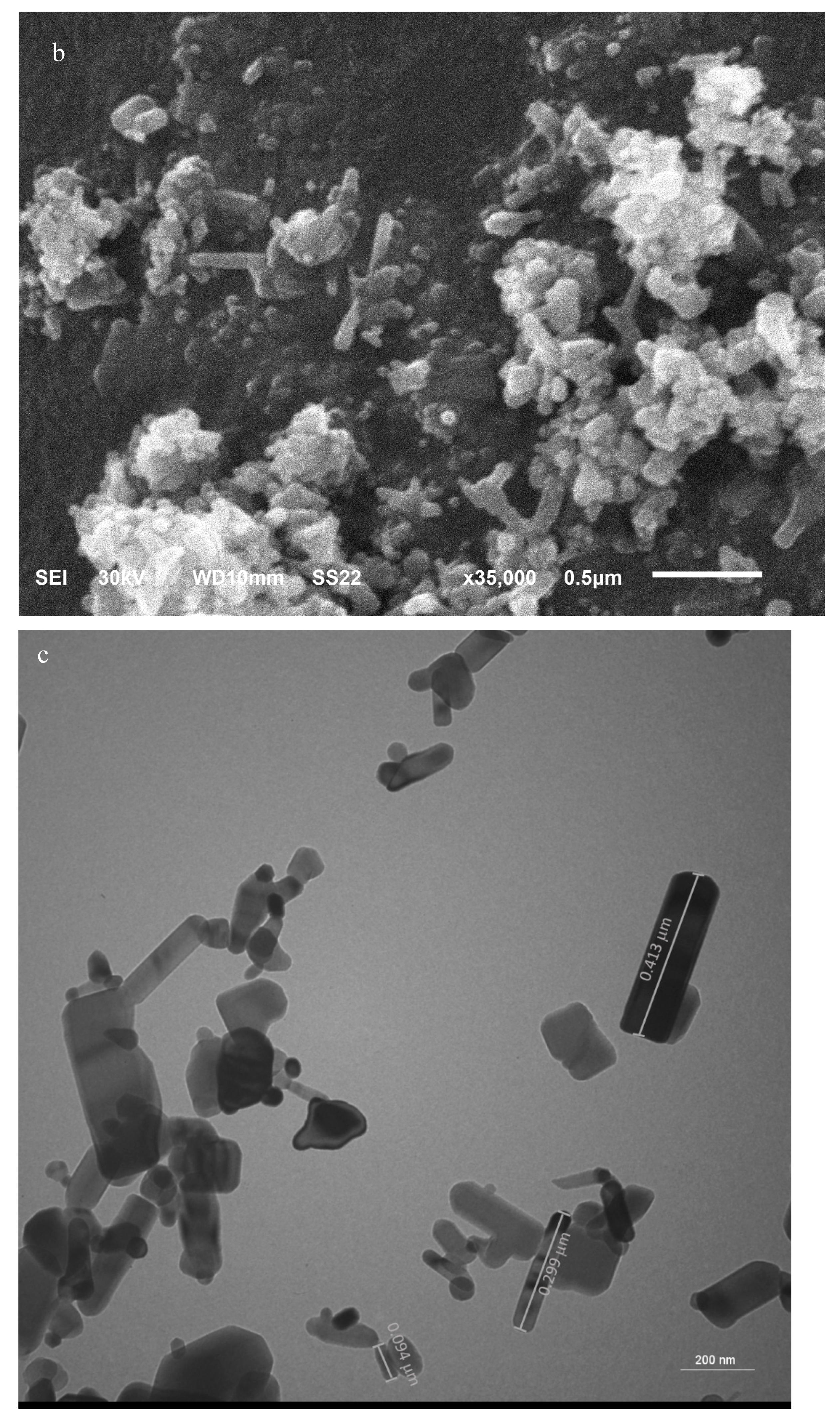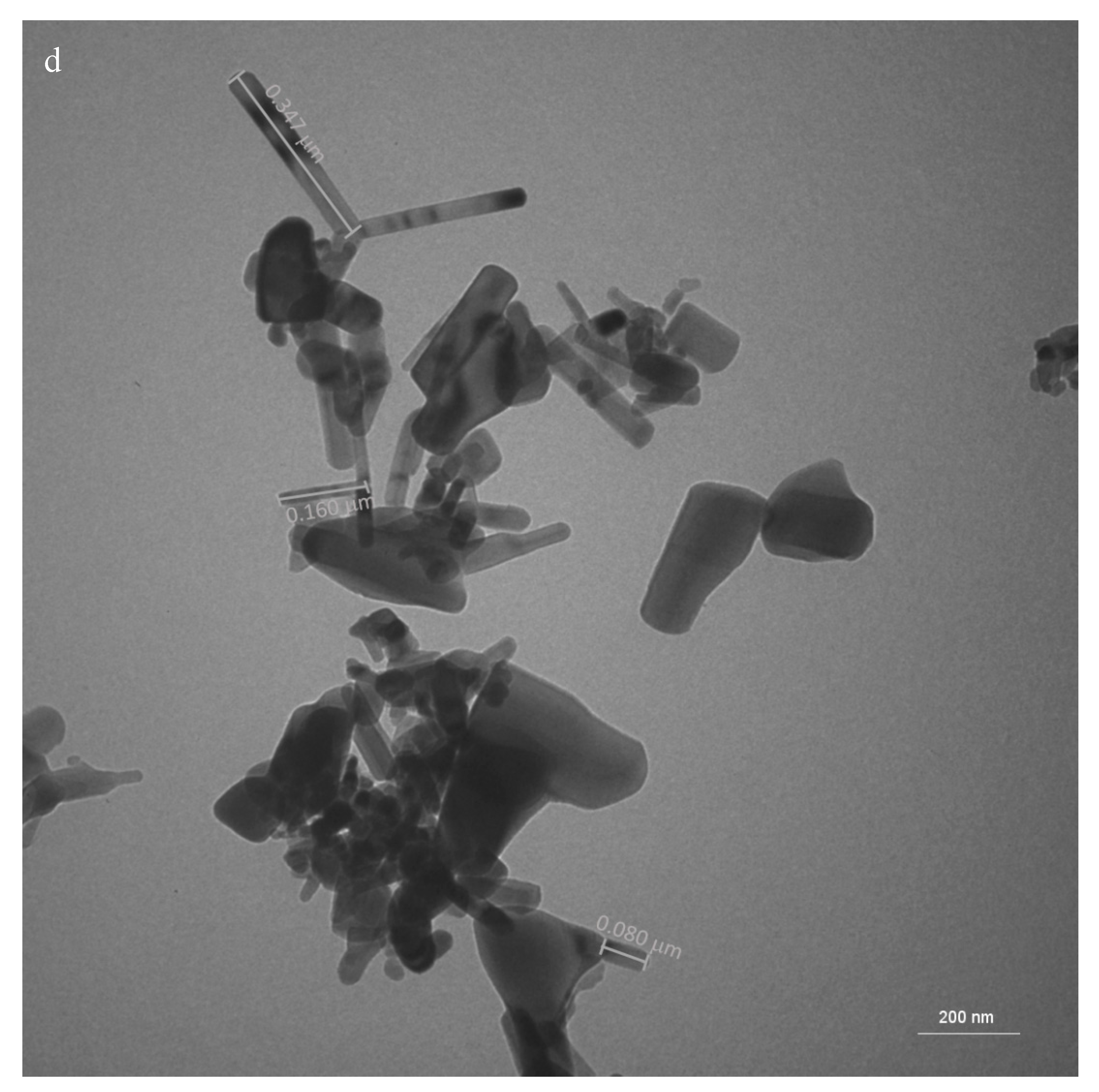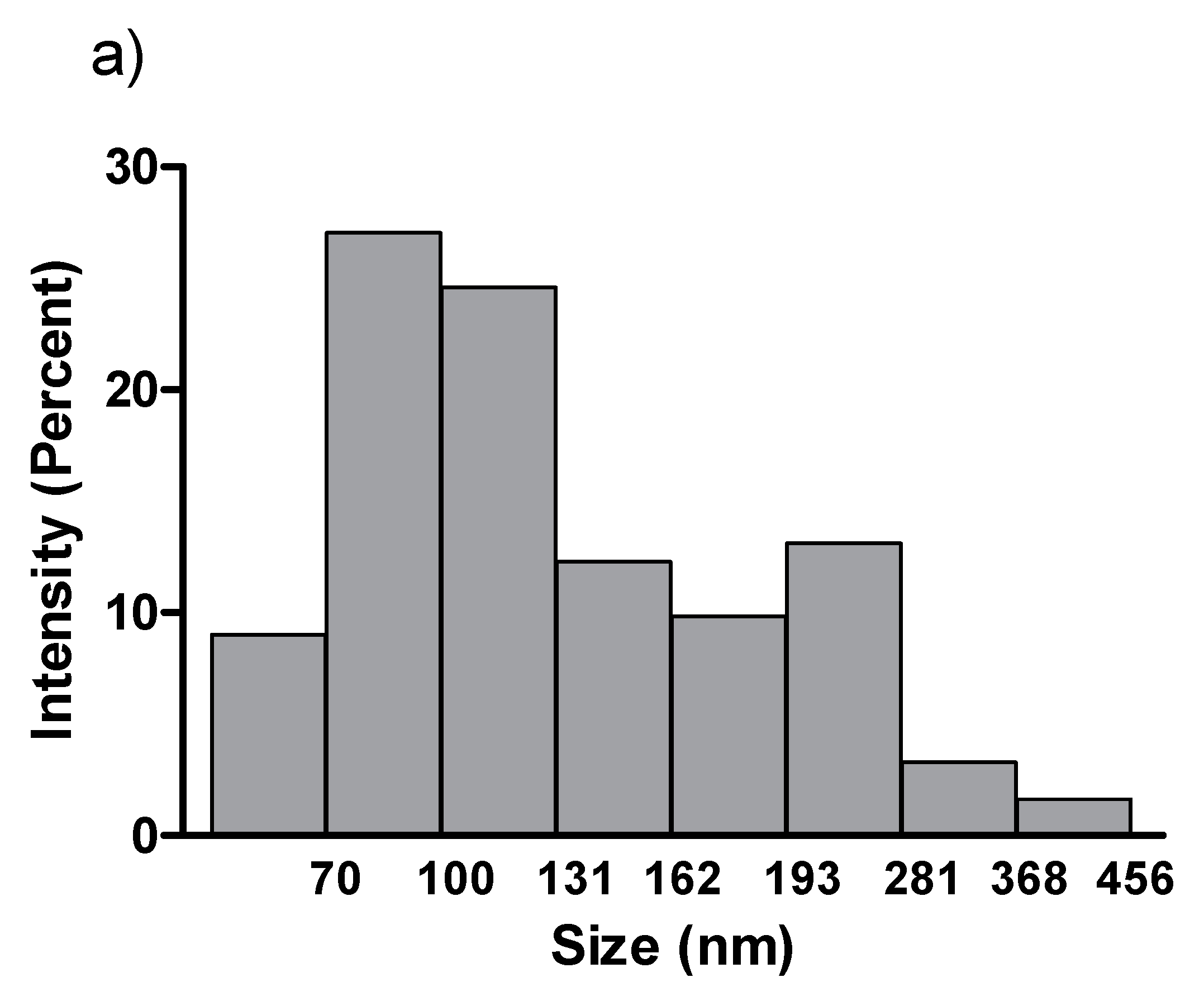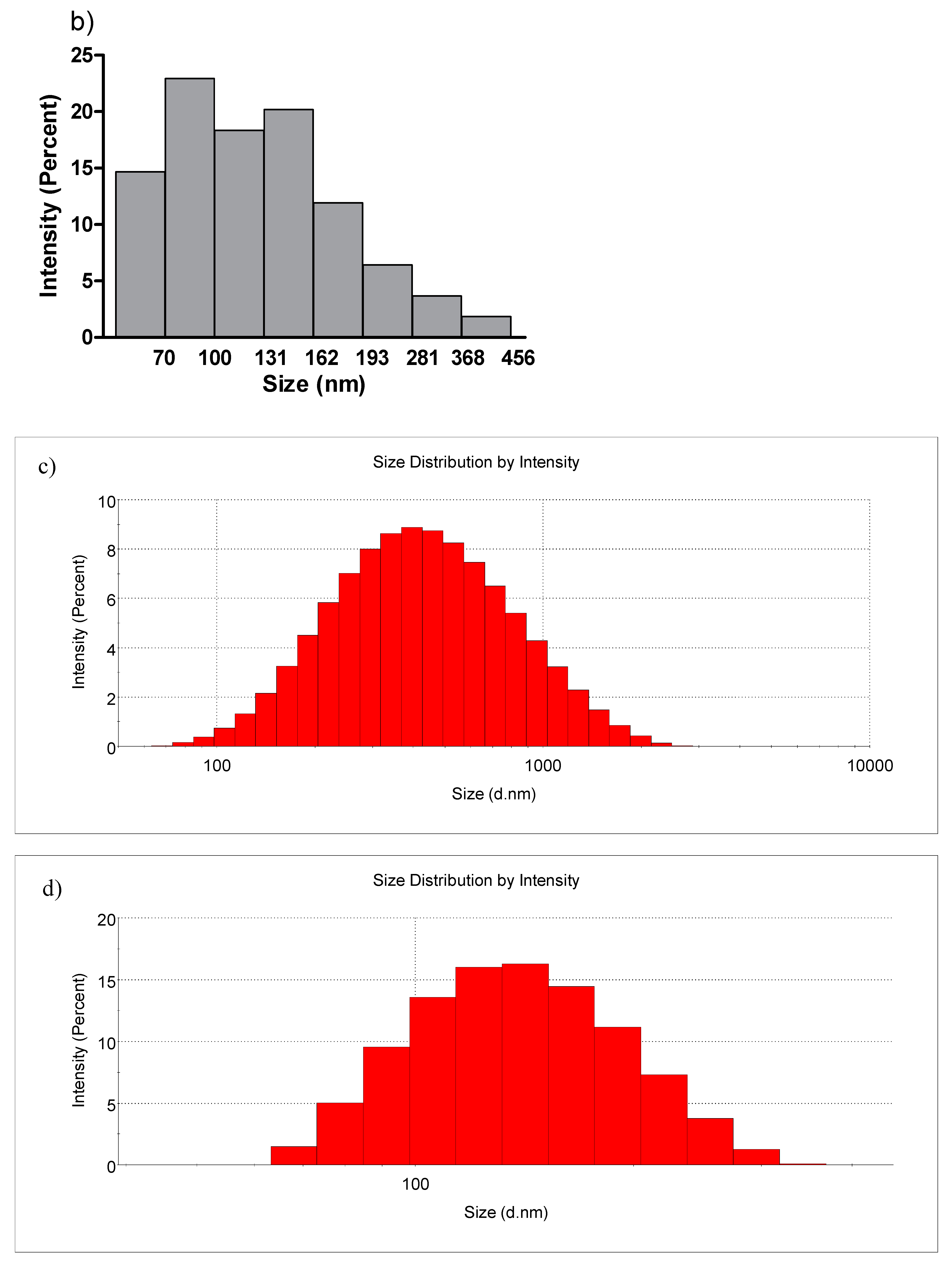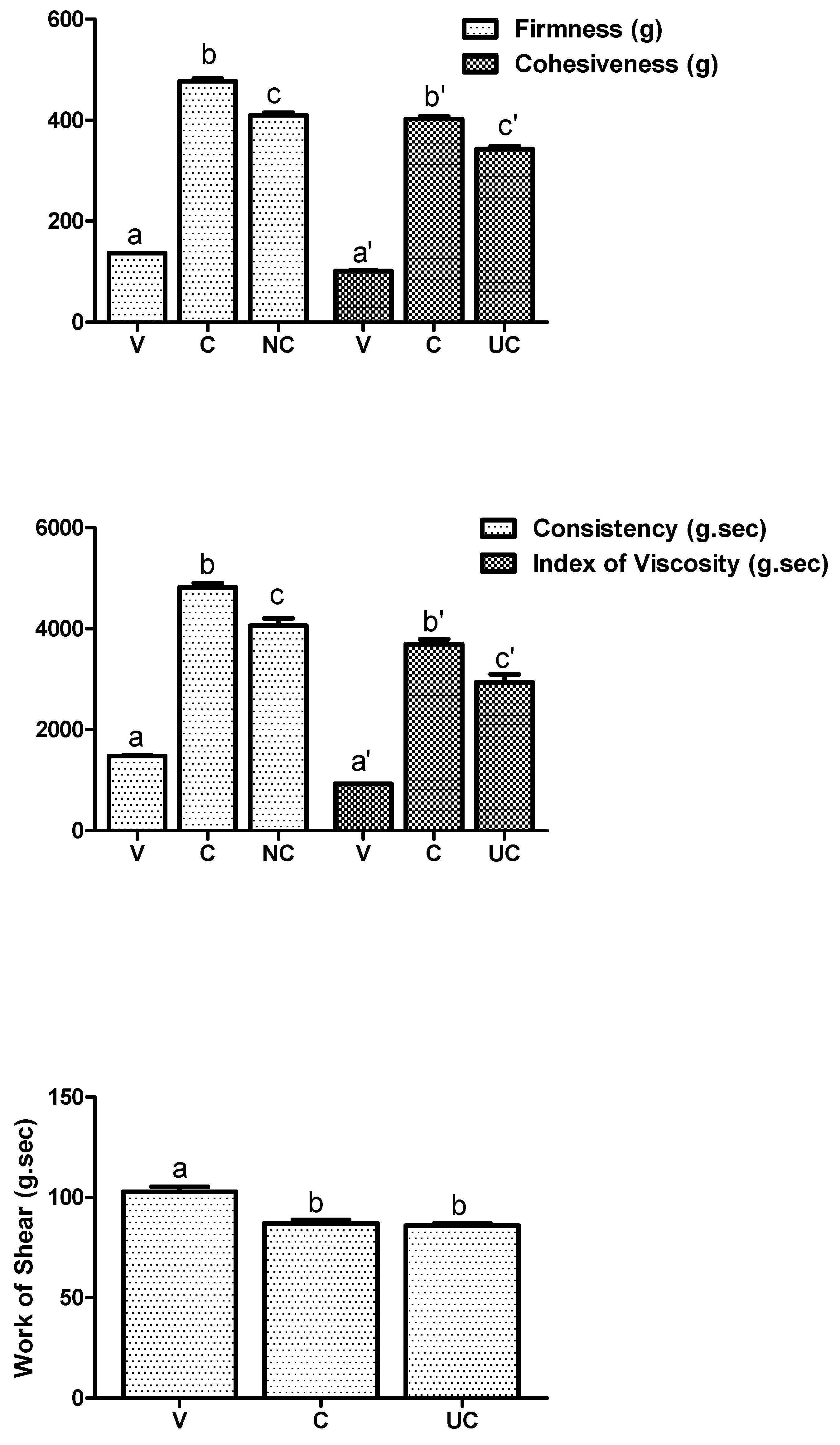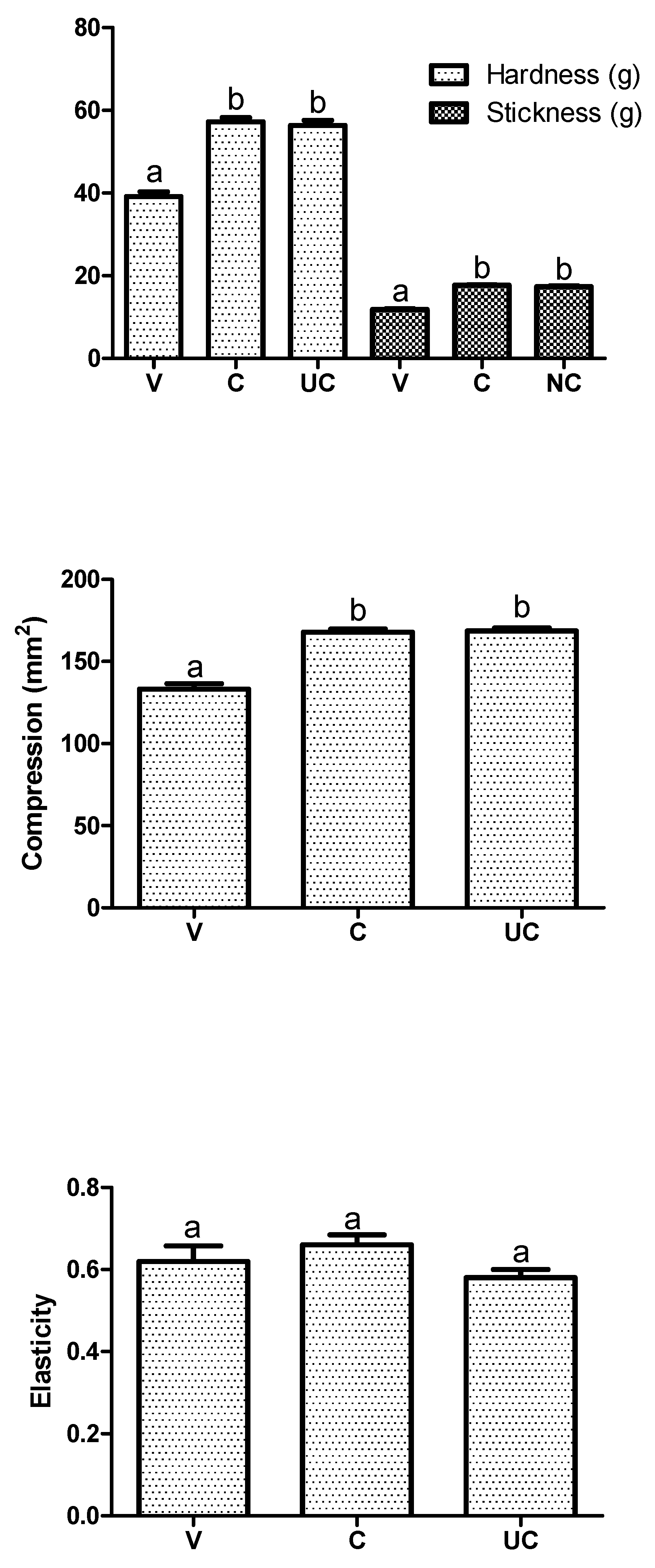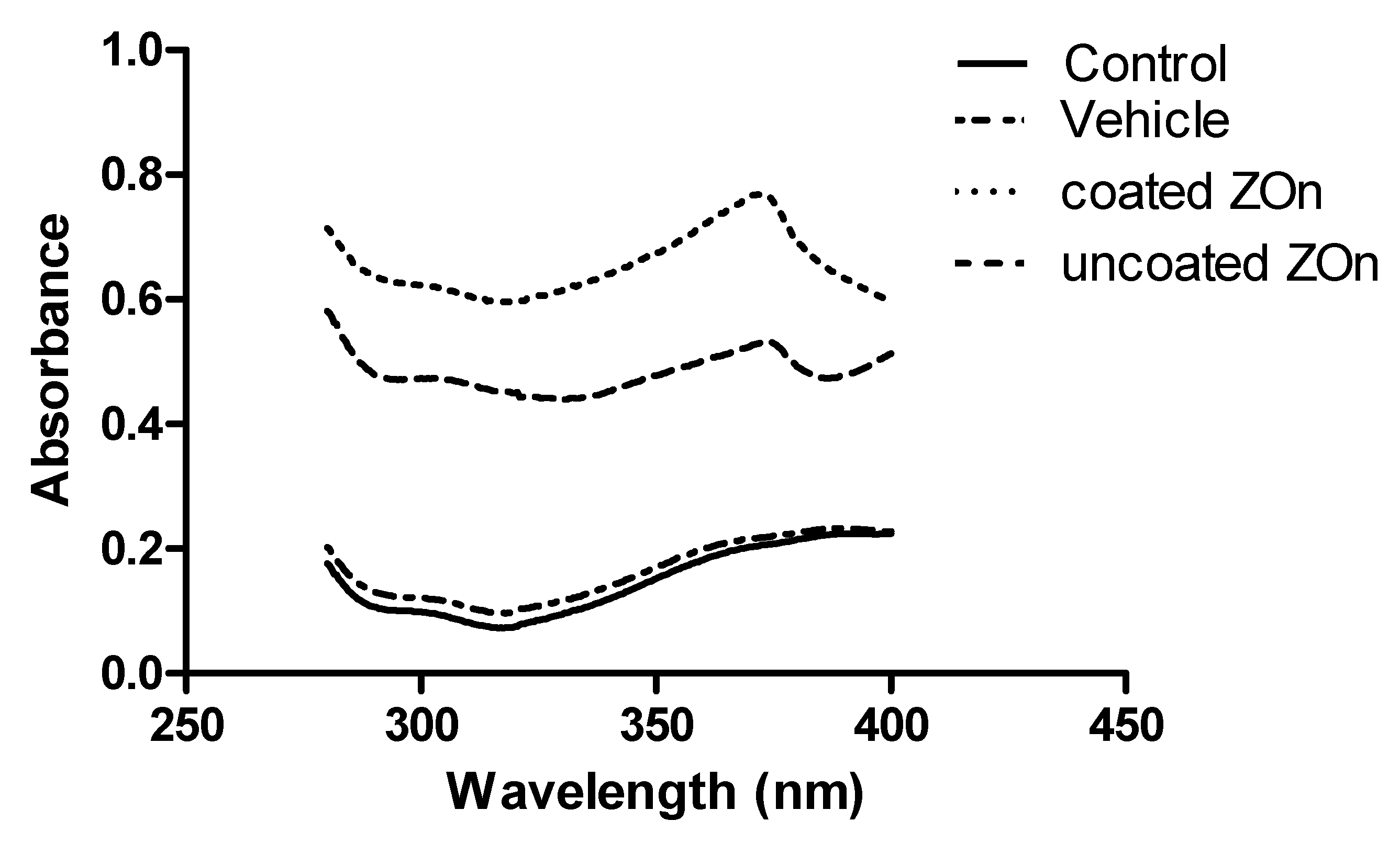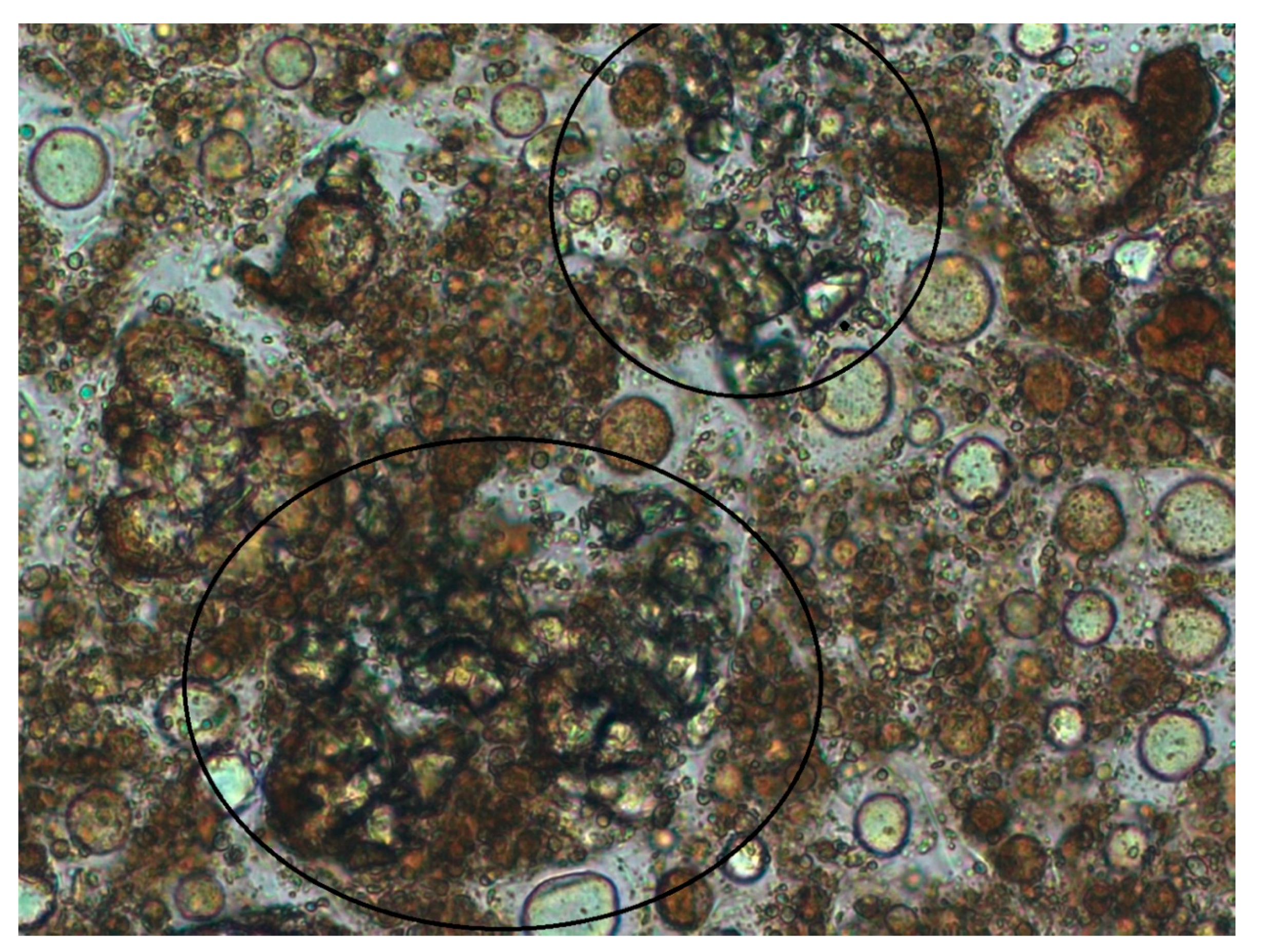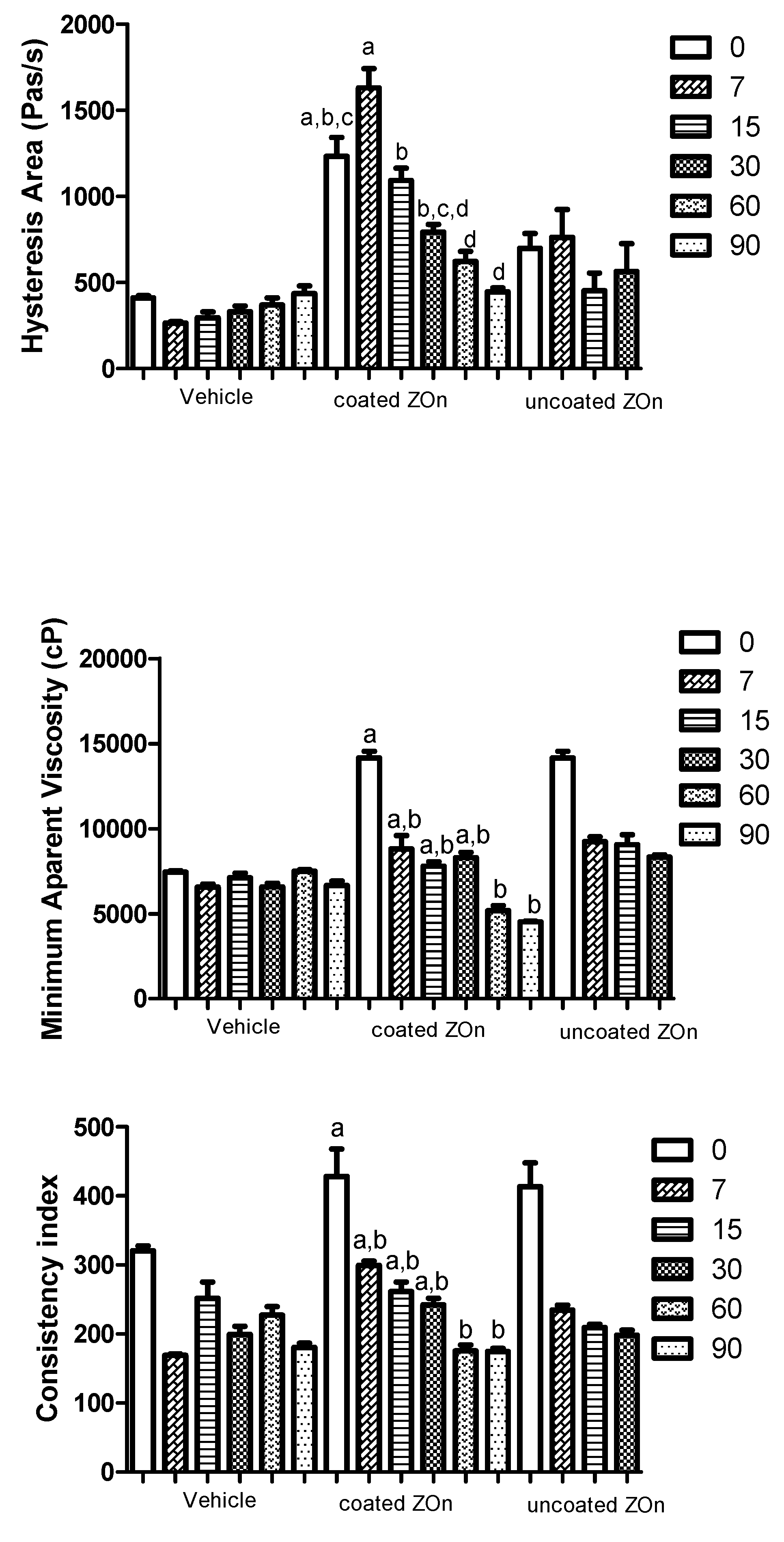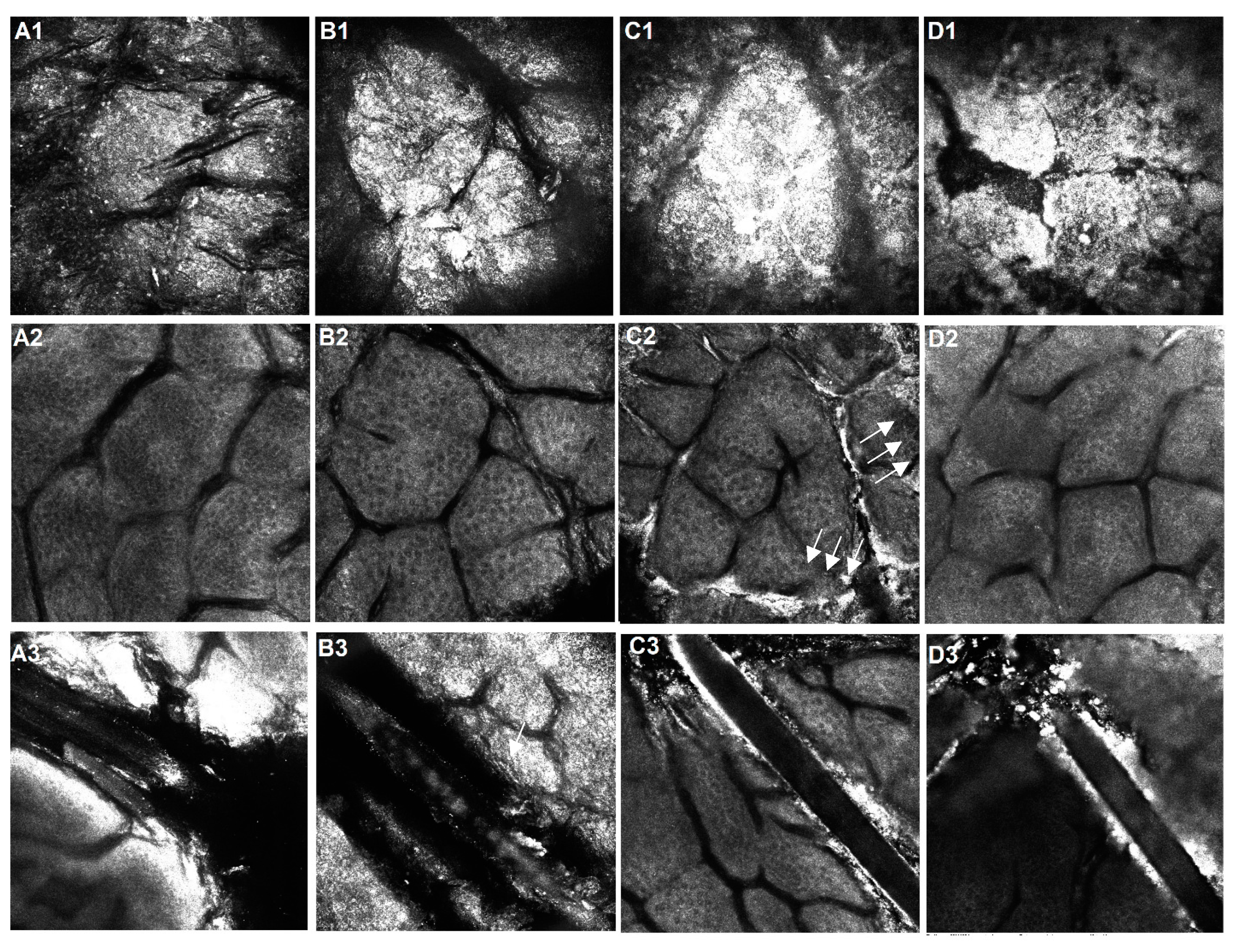3.1. Characterization of ZnOn
The International Organization for Standardization emphasizes that the physicochemical characterization of nanomaterials is critical for the identification of test materials before toxicological assessment (21). Therefore, the characterization of ZnOn was carried out before the development of the topical formulation.
The SEM evaluation showed that the ZnOn powders were highly agglomerated and aggregated, as visible in the micrographs (
Figure 1 a, b). The assessment of the morphology presented nanoparticles with rod, cubic, tetragonal, hexagonal and orthorhombic morphologies for both samples. In some cases, nanoparticles may enter the cell after binding to the receptor target. Once bound, several factors can dictate the behavior of nanomaterials at the nano-bio interface, e.g., the nanoparticle's shape may influences uptake into cells. For nanoparticles with size larger than 100 nm, rods show the highest uptake, followed by spheres, cylinders, and cubes (1). In this study it was observed a high incidence of rod-shaped nanoparticles in the coated and uncoated ZnOn; therefore, the cell uptake could be increased.
The assessment of the size of the uncoated (
Figure 1 c) and coated (
Figure 1 d) ZnOn by TEM varied from 55 to 413 nm and from 39 to 456 nm, respectively. For titanium dioxide, which is another inorganic filter, the nanoparticles with 30 nm have been demonstrated to induce the highest generation of reactive oxygen species (1). The presence of small sized nanoparticles in the uncoated and coated samples could result in the cell uptake of these nanoparticles, which could lead to cell damage.
The average of the max feret's diameter for the uncoated and coated ZnOn was 137 nm and 134 nm, respectively (
Figure 2 a, b). For the uncoated and coated ZnOn, 86.2% and 88.8% of the nanoparticles exhibited size lower than 200 nm, respectively, which indicates that although the ZnOn presented a large size distribution, the majority of the nanoparticles were encompassed in the group with size lower than 200 nm. The ratio of max per min feret’s diameter varied from 1.1 to 9.9 and from 1.1. to 5.6 for the coated and uncoated ZnOn, respectively. For the uncoated and coated ZnOn, 53.6% and 75.5% presented ratio higher than 2, respectively, which is characteristic of tetragonal, hexagonal and orthorhombic and long rod-shaped nanoparticles (18). For the coated ZnOn, the size of all the nanoparticles with ration lower than 2 was equal or lower than 200 nm. For the uncoated ZnOn, 94.7% of the nanoparticles with ration lower than 2 exhibited size lower than 200 nm. For the uncoated and coated ZnOn, 81.8% and 75.7% of the nanoparticle with ration higher than 2 exhibited size higher than 100 nm, respectively, which is characteristic of cubic and short rod-shaped nanoparticles (18).
A previous study employed the protocol used in this study for the hydrodynamic particle size determination using DLS (10 mg/3 ml deionized water; ultrasonic bath for 10s). They obtained an average hydrodynamic size and PDI of 340 nm, 192 nm and 0.2, 0.2 for the uncoated and coated ZnOn, respectively (10). In this study, the average hydrodynamic size and PDI for the coated ZnOn under these conditions were 371 nm and 0.295, respectively. The hydrodynamic size decreased for 282 nm when the samples were kept in an ultrasonic bath for 1 hour; however, the PDI increased for 0.332.
For the uncoated ZnOn, 3 mL of deionized water was not enough to suspend 10 mg of the nanoparticles, therefore, the sample were suspended in 6 mL of deionized water and were diluted 2 fold to achieve a hydrodynamic size and PDI of 368 and 0.259, respectively (figure 2 c). This concentration was the best result we obtained for the uncoated ZnOn; however, the mean hydrodynamic size is considerably higher than the mean feret’s diameter (137 nm), which suggests that DLS is not an appropriate methodology to assessment the size of the uncoated ZnOn under the tested conditions.
Other study encountered better results with the samples in the concentration 50 mg/L (18). Their results of hydrodynamic sizes and PDI for the uncoated and coated ZnOn was 275 nm, 253 nm and 0.145, 0.401, respectively. We tested this concentration (2 mg/40mL; 1 hour ultrassonic bath) and obtained similar results of hydrodynamic size and PDI for the coated ZnOn, respectively, 258 nm and 0.238. However, for the uncoated ZnOn the hydrodynamic size was remarkably higher, 962 nm (PDI: 0.258), which indicates substantial agglomeration
The hydrodynamic diameter found for the coated and uncoated ZnOn was larger than the feret’s diameters measured by TEM. That is often the case for several nanoparticles because when a dispersed particle moves through a liquid medium an electric dipole layer, which is often thin, adheres to its surface. Thus, the hydrodynamic diameter gives us information of the solvent layer attached to the particle as it moves under the influence of Brownian motion (22).
Aiming to reduce the agglomeration, organic solvents were tested in order to improve the solubilization of the nanoparticles. The coated ZnOn solubilized exceedingly well in ethyl acetate. The sample was visually stable with no signs of sedimentation, which suggests that the particles were undergoing Brownian diffusional motion throughout the measurement.
The average hydrodynamic size and the PDI for the coated ZnOn in ethyl acetate (2 mg/ 10 mL; diluted 10 fold) was 135 and 0.149 respectively (figure 2 d). Although the PDI indicates a polydisperse sample (values smaller than about 0.04 are considered monodisperse) (18), this could be a characteristic of the sample, rather than an indication of the poor applicability of the technique. The size found by DLS was compatible to the feret’s diameter (134nm), which suggests that opposed to what has previously been believed (10, 18), DLS is an appropriate technique for measuring the mean hydrodynamic diameter of the coated ZnOn if the nanoparticles are suspended in ethyl acetate. DLS is a technique widely used to assess hydrodynamic diameters of nanoparticle dispersions; therefore, these results are important to substantiate the use of this technique for the coated ZnOn.
The zeta potential for the coated (10 mg/ 3 mL; diluted 2 fold) and uncoated (10 mg/ 6 mL; diluted 20 fold) ZnOn in deionized water was -19.5. and 21.3, respectively. It has been discussed that the smallest agglomerate size are achieved when the nanoparticle displays a strongly charged surface. The intense charge on the surface increases the charge-charge repulsions between the particles, thus maintaining a more stable and monodisperse suspension (23). However, for the tested ZnOn, the zeta potential was high and there was still significant agglomeration. The results for the zeta potential are in agreement with other studies that show that uncoated zinc oxide nanoparticles often exhibit positive zeta potential, while the nanoparticles coated with triethoxycaprylylsilane exhibit negative zeta potential (10, 18, 23). This indicates that the coating material may be associated with the shift in the zeta potential. Moreover, it has been suggested that positively charged nanoparticles are taken by the cells at a faster rate than nanoparticles with a neutral or negative charge, (1). This suggests that the skin toxicity may be different for the two ZnOn tested.
Furthermore, the zeta potential of the coated ZnOn in ethyl acetate (2 mg/ 10 mL; diluted 10 fold) was 0.0657. It has been suggested that a hypothetical model nanoparticle exhibits the largest agglomerate size at the point where its zeta potential is 0 mV (23). However, in ethyl acetate the zeta potential was close to zero and there was no significant agglomeration, which is possibly related to the low conductivity of the non aqueous dispersant.
3.2. Development and characterization of the topical formulations
Several formulations were tested aiming to incorporate 20% of ZnOn in the formulations. Initially the formulations were tested in water instead of buffer to avoid instability due to incompatibility. The first formulations were developed based on a previous study (24) and the main ingredients were ceteareth-20, cetearyl alcohol and a different polymers, besides emollients and humectants. Formulations employing a non ionic self emulsifying base (Cetearyl Alcohol, polyoxyethylene derivative of a fatty acid ester of sorbitan) and an anionic self emulsifying base (Mineral Oil, Isopropyl Palmitate, Trilaureth-4 Phosphate, Rapseed Oil Sorbitol Esters and Ammonium Acryloyldimethyltaurate/VP Copolymer) were also tested. The amount of 20% of ZnOn solubilized in Caprylic Capric Triglycerides was firstly incorporation in the formulation in the end of the process of preparation, which resulted in immediate phase separation. Therefore, the ZnOn were then incorporated either in the aqueous (uncoated ZnOn) or oil phases (coated ZnOn). None of the above mentioned formulations were stable and in up to 5 minutes they exhibited a distinguished appearance: the formulations presented characteristic white color and were fragmented in small granules with medium consistency, suggesting the consumption of the water.
The formulation with the non-ionic self emulsifying base presented in
Table 1 resulted in an initially stable formulation. The formulation was firstly prepared in water and latter prepared in buffer to avoid pH variation. It was observed that the formulation prepared in buffer was more consistent than the one prepared in water. Moreover, it was observed that the addition of the ZnOn increased considerably the pH. Using a buffer with the pH 3.5, the vehicle pH was 4, while the pH of the formulations containing ZnOn was 8.0. Therefore, the formulations were prepared in buffer pH 5.0, which resulted in a vehicle with pH 5.5 and formulations with pH 8.0. The pH of the formulations containing ZnOn decreased up to approximately 6.1.
3.2.1. Characterization of the topical formulations
The zeta potential of the vehicle and the formulations containing the uncoated and coated ZnOn were -22 mV, -13 mV and -8 mV, respectively. It was observed that the incorporation of ZnOn decreased the zeta potential, which could destabilize the formulation.
The texture parameters showed that the work of shear of the formulations containing the ZnOn were not significantly different and were smaller than the vehicle (
Figure 3). The work of shear represents the total amount of force required to perform the shear process during the texture test (25) and it is inversely related to the spreadability of the sample (26). Therefore, the formulations containing the ZnOn presented lower work of shear, which indicates that the incorporation of the nanoparticles in the vehicle led to formulations which were easier to spread.
The visual evaluation of the formulations suggested that the incorporation of ZnOn led to more consistent formulations, which was confirmed by the higher values of firmness, cohesiveness, consistency and index of viscosity for the formulations containing ZnOn compared with the vehicle (Fig. 3). Firmness represents the maximum force during the probe penetration to shear in texture test (25). This suggests that during the test, the formulations containing ZnOn endured the application of higher force than the vehicle, but less force was required for the formulations containing the ZnOn to be spread. In addition, the formulation containing the coated ZnOn presented higher texture values than the formulation containing the uncoated ZnOn but the work of shear was not statistically different. This indicates that the increase in firmness, cohesiveness, consistency and viscosity index for the formulation containing the coated ZnOn was not substantial enough to affect the spreadability of the formulation.
Thixotropy is defined as the continuous decrease of viscosity with time when flow is applied to a sample that has been previously at rest and the subsequent recovery of viscosity in time when the flow is discontinued (27). Therefore, topical formulations with a thixotropic behavior are highly desired because they deform during the application. It is interesting to obtain a thixotropy value not too high so that the product does not run on the skin after application but not a very low value, since it can result in low spreadability and non-uniform distribution on the skin (28).
The formulation containing the coated ZnOn presented significantly higher thixotropy than the vehicle and the formulation containing the uncoated ZnOn (Figure 8). Although the work of shear was significantly different between formulations containing ZnOn, the thixotropy suggests that the formulation containing the coated ZnOn could have better spreadability, which reinforces the results of the texture parameters. In addition, the texture and thixotropy results suggest that the coating of the nanoparticles with triethoxycaprilylsilane may have had a positive impact on the texture and spreadability of the formulation.
Elasticity is the ratio of the duration of contact with the sample between the second and first compression, which indicates the rate at which a deformed material returns to its undeformed condition after the deforming force is removed (29). As shown in
Figure 4, there was no change in elasticity between the formulations developed, and the value found suggests that the formulations exhibit low elasticity compared with other topical formulations (30).
Hardness is the maximum force applied to the sample during the first compression cycle (29) and the compressibility corresponds to the area (30). The stickiness is given by the force at the maximum point in the second compression cycle. Thus, a stickier sample will require a greater force for the probe to be removed (25). The hardness, stickiness and compressibility of the formulations containing the ZnOn were higher than the vehicle (
Figure 4). For these parameters, there was no significant difference between the formulations containing the ZnOn. This suggests that the incorporation of the nanoparticles led to a physical alteration in the formulation, but coating the nanoparticles with trietoxicaprilylsilane did not influence the evaluated parameters.
3.2.2. Stability Evaluation
Functional stability
The functional stability was evaluated spectroscopically by the ability of the formulations to reflect the radiation.
Figure 5 shows the absorption spectrum of the formulations developed and suggests that the absorption capacity of the UVA / B radiation of the formulation containing the coated ZnOn is higher than the formulation containing the uncoated ZnOn. The absorption capacity of the vehicle's UVA / B radiation was very similar to that of the control, indicating that the FPS would be close to zero.
The area under the curve of the samples at 0, 15, 30, 60 and 90 days was calculated and it was not possible to observe a change in the functional stability of the samples, since the area under the curve ranged from 61.1 to 58.9; from 39.7 to 42.8 and from 3.2 to 4.1 for formulation containing coated, uncoated and vehicle nanoparticles at 0 and 90 days, respectively. Thus, apparently the ZnOn did not undergo any process of degradation that resulted in loss of activity.
Structural stability
The microscopic evaluation suggested the tendency of the nanoparticles to agglomerate in the formulations. Nanoparticles have strong crystal attractions which form clustered, tightly bound aggregates. Aggregates are the smallest particles which can be found in sunscreen formulations, because the forces required to break apart aggregates are far greater than those forces encountered during production or during application onto the skin (3). The instability signs were defined as the presence of agglomerates with different characteristics than the native agglomerates of the formulation.
Figure 6 shows micrographs at 0 and 90 days. It was not possible to observe any clear signs of instability for the vehicle during the study time (
Figure 6 a,b). The formulations containing the uncoated ZnOn showed instability signs at day 60. The circled area points out the structures that appeared at day 60 (Fig. 6 d). For the formulations containing the coated ZnOn, signs of instability were detected at day 90 (white arrows in
Figure 6 f, which are more clearly presented in
Figure 7). The instability signs observed for the formulation containing the coated ZnOn had a crystalline appearance and were less evident than for the formulation containing the uncoated ZnOn.
For the size evaluation by DLS, the vehicle presented a hydrodynamic size of 309.4 nm (PDI of 0.400) at time 0, indicating the presence of polydisperse nanoparticulate material in the formulation. At day 15, the size decreased to 192.9 nm (PDI of 0.308) and was maintained until the end of the study. The formulation containing the uncoated ZnOn presented a hydrodynamic size of 534 nm (PDI of 0.500) at time 0. At day 7, the size decreased to 439.2 nm (PDI: 0.417) and was maintained until the end of the study. The formulation containing the coated ZnOn presented a hydrodynamic size of 307 nm (PDI of 0.324) at time 0. At day 7, the size increased to 389 (PDI of 0.467) and was maintained until the end of the study. Evaluation of the hydrodynamic size of the formulations indicated a reorganization of the vehicle molecules from time 0 to 15 days. The same was observed for the formulations containing the ZnOn from 0 to 7 days. The DLS technique resulted in a satisfactory characterization of the formulations, but it was not able to detect instability signs possibly because the formulations were polydisperse. Moreover, the vehicle also presented nanoparticles, which might have interfered in the size determination of the ZnOn in the formulations.
Physical stability- rheological assessment
At day 60, an aqueous buildup was observed on the surface of the formulation containing the uncoated ZnOn, which is suggestive of instability. The rheological analysis confirmed the instability of the formulation and due to the lack of homogeneity, it was not possible to obtain reproducible rheograms. Thus, Supplementary
Figure 1 shows the rheograms of the vehicle and the formulation containing the coated ZnOn at 0, 7, 15, 30, 60 and 90 days, while the rheograms of the formulation containing the uncoated ZnOn are presented only at 0, 7, 15 and 30 days.
The rheological characterization of the formulations and the evaluation of the viscosity, flow index, consistency index and thixotropy allow a better understanding of the physico-chemical nature of formulations in the development phase. In addition, it allows to control the quality of raw materials and finished products, to evaluate the effect of the consistency of the product on the release and skin penetration, besides contributing to the prediction of the shelf life of the product (31). The formulations did not show significant variation in the flow index during the study time, and presented flow index lower than 1, which indicates pseudoplastic behavior. Pseudoplastic materials exhibit non-Newtonian flow and are characterized by the reduction of viscosity with the increase of the applied force (32). This behavior is the most common in cosmetic formulations and presents a characteristic film formation on the surface of the skin (33).
Figure 8 shows the variations in the hysteresis area, consistency index and minimum apparent viscosity for 90 days. For the vehicle, there was no significant variation in the parameters for 90 days. For the formulation containing the uncoated ZnOn, there was no significant difference in the parameters for 30 days. At 60 and 90 days, it was not possible to perform the rheological analysis due to the instability of the formulation, which compromised the reproducibility of the results. For the formulation containing the coated ZnOn, there was no significant difference in the parameters for 30 days. At 60 and 90 days there was a decrease in the hysteresis area, minimum apparent viscosity and consistency index compared to time 0. Therefore, the formulations and the vehicle were considered stable for 30 and 90 days, respectively.
3.4. Penetration assessment
RCM imaging is a noninvasive technique that shows nuclear and cellular-level morphology. Imaging is based on the detection of singly backscattered photons from the optical section and contrast is due to the relative variations in refractive indices and sizes of organelles and microstructure (34).
Figure 9 shows RCM images of the stratum corneum (A1, B1, C1, D1), granular layer (A2, B2, C2, D2) and hair/hair follicle (A3, B3, C3, D3) of porcine skin treated with the vehicle (B) and the formulations containing the coated (C) and uncoated (D) ZnOn. Higher reflectance in the stratum corneum was observed for the skin treated with the formulations containing the ZnOn, which suggests the presence of the ZnOn. The formulation containing the coated ZnOn evidently accumulated on the skin furrows (
Figure 9. white arrows), which was not observed for the formulation containing the uncoated ZnOn.
Although the uncoated ZnOn did not show major accumulation on the skin furrows, the coated and uncoated ZnOn accumulated around the hair and in the hair follicles (
Figure 9 C3 and D3). Whereas for the vehicle and the non treated skin, it was possible to observe the hair up until the medulla (
Figure 9, A3 and B3, white arrows), a thick coat of nanoparticles covered the hair, which prevented the visualization of the inner part of the hair. Though the penetration assessment was carried out in porcine skin, the size of the porcine hair follicles corresponds approximately to the size of human terminal hair follicles. Therefore, results can be expected to be similar in human terminal hair follicles. (35).
The increased reflectance in the skin treated with the formulation containing the coated ZnOn was observed only in the skin furrows and hair follicles, but not within the keratinocytes, which could suggest that the nanoparticles did not enter the cells. In addition, the honeycomb pattern was maintained in the skins treated with the formulations and there were no signs of inflammation in 12 hours. However, it is possible that the penetration was underestimated for the skins treated with the formulation containing the uncoated ZnOn. These nanoparticles did not have a protective cover and the zinc ions could have been liberated from the ZnOn accumulated on the stratum corneum, promoted by the hydrolysis of ZnOn to Zn2+ at the normal acidic pH of the skin (5).
For many years, the penetration of topically applied substances through the stratum corneum was assumed to be diffusion inside the lipid layers surrounding the corneocytes. In the last decade, investigations attributed that the hair follicles perform a significant part in skin penetration (36). Moreover, studies have shown that nanoparticles accumulated in hair follicles can remain in the follicles for up to 10 days until gradually cleared by sebum flow (36). Hair follicle stem cells play vital roles in the hair cycle and skin regeneration after injury. ZnOn that accumulated in hair follicles have been shown to impair the transcriptional activity of genes important for hair follicle stem cells differentiation and increased the expression of apoptosis-related proteins. The pathways involved in cellular communication, cell differentiation, and RNA biosynthesis were also altered (12). A recent study using Franz diffusion cell showed that ZnOn accumulated on the skin surface and within the skin furrows but did not enter or cause cellular toxicity in the viable epidermis, however zinc ion concentrations in the viable epidermis of excised human skin were slightly elevated (5).
The protocol used in this study employed one application of the formulations. The formulations accumulated on the skin furrows, hair and hair follicle; however, it is evident that repeated daily application of ZnOn may lead to an increase in the concentration of zinc species in the skin (5). Therefore, to clarify the safety concerns, biochemical markers of oxidative stress and inflammation should be assessed after prolonged use of formulations containing ZnOn.
